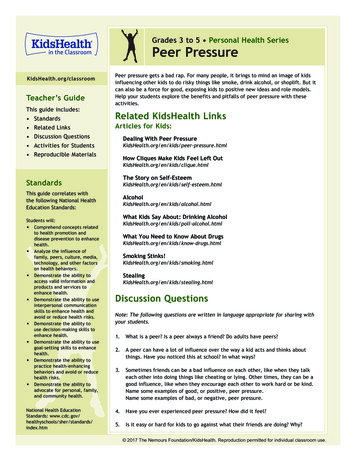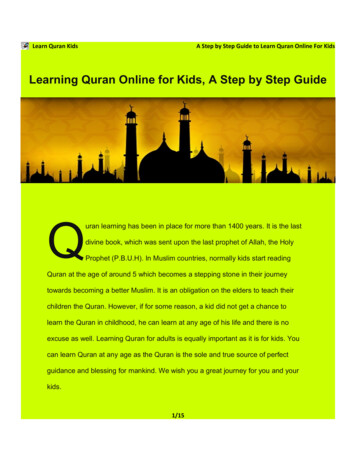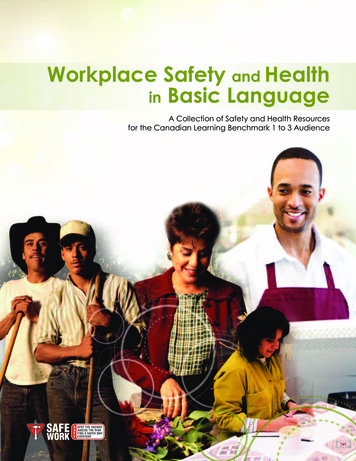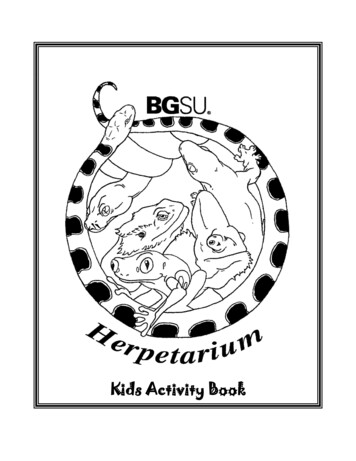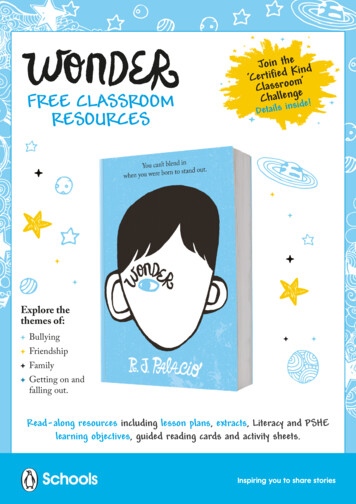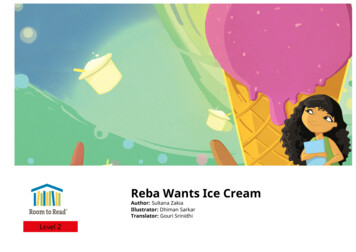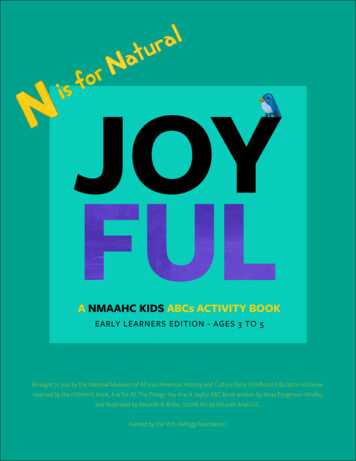
Transcription
A NMAAHC KIDS ABCs ACTIVITY BOOKEARLY LEARNERS EDITION - AGES 3 TO 5Brought to you by the National Museum of African American History and Culture Early Childhood Education Initiative.Inspired by the children’s book, A is for All The Things You Are: A Joyful ABC Book written by Anna Forgerson Hindleyand illustrated by Keturah A. Bobo, 2018 Art by Keturah Ariel LLC.Funded by the W.K. Kellogg Foundation.
A is for All the Things You Are was written to affirm ourchildren and empower them to see themselves as many things at once – daringand loving, creative and just, amazing and zany – and everything in between.The book offers wonderful opportunities for conversations with children tobuild their vocabularies, strengthen their sense of self and deepen their joyin and acceptance of human diversity. The illustrations allow them to see notonly themselves but others in the same positive light as well. By seeing positiveimages of children of different colors, genders, abilities, classes, and other socialidentities, we nurture the child’s comfort and joy in human diversity so deepcaring connections can be made across humanity. In exploring ideas such asfairness, kindness, open-mindedness and being vocal, children begin the task ofrecognizing injustice and knowing how to stand up for themselves and others.Each activity booklet offers suggestions of how to begin the lifelong work ofhaving a positive sense of self and others with your early learner, how to supporttheir language development and how to build the foundations of literacy.A Is for All the Things You Are: A Joyful ABC Book 2018 Art by Keturah Ariel LLC (artwork) 2018 Smithsonian Institution (text)1
N is for Natural:Your skin, your hair, and your eyes are part of your natural self. Those things areuniquely your own and are part of what makes you special.How will you show your pride in yournatural, beautiful self?Three to six year olds are excellent observers, and even though they oftendon’t have the words to express it, they pay close attention to the subtle wayssociety lets them know what is valued and what is not. These are key yearsfor trusted adults (that’s you!) to help children to feel happy about the bodythey live in - exactly as it is now, without focus on what we or the world aroundthem thinks their body will be or should be based on factors like race, genderor ability.l ABC BookA Is for All the Things You Are: A Joyfuork) 2018 Art by Keturah Ariel LLC (artw 2018 Smithsonian Institution (text)It is a huge support to children to be given positive, accurate words to describe characteristics like hair textures, eye andbody shapes or skin color rather than to absorb society’s racial and gendered stereotypes about the “normal” way to lookand be. Their personal confidence and joy in the diversity of others is strengthened by on-going conversations with loving,anti-bias adults about how everyone is alike and different and how interesting and wonderful that is!The way we model pride in our own natural, physical selves is just as important as the words we give our children about theirown. Our courage to stand up to the world’s judgements that tell us we are too fat, too short, too dark or too different canencourage our children to do the same! This week, as you delight in the body your child lives in, take time to appreciate yourown as well. There’s no one just like you in the whole world. You are special.WhatYou’ll Need:The following supplies are suggested for the experiences in this booklet. Tip:Yarn, string, ribbons or scarvesTapePaper Markers and crayons Pencil or black marker Chalk (optional)Watercolor paint and brushesBuild an at-home creativity kit full of all the supplies and recycled materialsyou’ll need for future ABC art and play activities. Find the supplies list here!2
EXPLOREIn early childhood, children learn best through doing! Explore this week’s theme with your child by trying thisengaging experience inspired by our museum collection.LovingYour Natural HairEmbrace Your Hair. Watch We Love Our Hair and read a book with photosof real and diverse children, like Shades of People by Shelley Rotner. Talk aboutthe different textures and colors hair can have and how hair helps us. The wayhair naturally grows from everyone’s heads is worthy of admiration. What doyou love about your hair? Look in a mirror, touch your hair and describe it.Offer words like long, short, thick, flat, curly, wavy or straight.Learn about hair styles. Braids and twists are hairstyles in Blackcommunities that express creativity, show pride in Black culture and Africanancestry, and care for natural hair textures. Braiding and twisting hair takes alot of practice. Braids are a style found in many other communities but theyare styled in different ways. Do you or people in your family or communitywear braids?This week, practice braiding and twisting with yarn, ribbon, long scarves orfabric strips. Start with two pieces of ribbon or yarn held down with tape or tied tosturdy furniture.Serena and Venus #2 by Roderick J. Lyons Invite your child to twist the two pieces together. Then, with patience and grace, try braiding. Model how, one strand at atime. Remember, braiding and twisting require children to use different levels of fine motor skillsand are skills that take time and a lot of practice to learn. Be sure to keep this experience fun!Caregivers: Learn more about the importance and history of braids in Black culture.Tip:Be sure to include all genders in this experience.3
CREATECreate art inspired by this week’s theme!YourSpecialEyesEyes are all different shapes. Some are round like circles, shaped likealmonds or look like small crescent moons. For some people, eyes helpthem look at the world around them all on their own. Other eyes may needglasses while some eyes can’t be used to see. From light and dark shades ofbrowns to many kinds of blues and greens, eyes come in many shades andcolors. Eyes in every shape and color are special!Portrait of Micheal TaylorPaint a picture of your eyes. Start by looking closely at your eyes. Whatshapes are they? Do they change shape when you smile? What colors areyour eyes? How are your eyes the same or different from your grown-up’s eyes?eedlNWhat You’lerr black mark Pencil opapereet of white Large shnd brushlor paints a Waterco1Begin to draw the shape of youreyes with a pencil or marker.Remember to add your eyelidsand eyelashes. Try to fill the page!2On a small plate, mix water with paint from different watercolor tabsto create a shade that is most like your wonderful natural colors. Thenbegin to fill in the iris and pupils of your eyes with colors and details likelines or specks.3In the blank space on your paper, work together to write downwords that you used to describe your eyes, colors or patterns thatyou love.Tip:Support your child’s self-love by teaching them how their body works!While drawing and painting, talk about the different parts of an eye.4by Martha Olson
LEARNInvite your child to take part in the following experiences to support their literacy and language skills.CelebratingYour Body’sShapesWhat You’ll Need Markers or crayons PaperBodies come in many shapes and sizes. Some bodies are smallor tall and others are short or big. Our bodies are always changing.Everyone’s bodies have some things that are the same and some thingsthat are different. All bodies are loveable and wonderful just the waythey are! What is something you love about your body? What doesyour body help you do?Trace body parts. Tracing helps to strengthen hand-eye coordination and gives children opportunities to practice the finemotor skills required for writing. Start by asking your little one to place their non-dominant hand on a blank piece of paper.Then, model how to use a marker or crayon to trace along the sides of their hand and in between fingers. For a differentchallenge, encourage them to try tracing with the opposite hand, allow them to trace your hands, or trace feet. As they trace,talk about the beautiful color of their skin and the wonderful ways they can use their hands - from holding utensils or pickingup things to holding a friend’s hand or giving a high-five.Try this! Take turns lying down on the sidewalk and tracing each other’s bodies with chalk. (Make sure that the concreteisn’t too hot or too cold!) Talk about the similarities and differences of your body shapes. Fill in the shape with positve words,colors, letters or body parts drawn with chalk.5
EXPLORE MOREChildren notice skin color starting in infancy and begin to form beliefs about what the colors mean about themselves andothers, whether we talk about it or not. As a caregiver in the life of young children, you have the special opportunity to showthem the beauty of diverse skin colors and the specialness of their own skin. Use the resources below to learn more about howchildren understand skin color and race, and to support your child’s positive identity development in fun and meaningful ways.BooksDiscover how we get our skin colors, the many shades skin can be and the awesome things that skin can do!Shades of Black: A Celebrationof Our ChildrenHappy In Our Skinby Fran Manushkin,illustrated by Lauren Tobiaby Sandra L. Pinkney,photographs by Myles C. PinkneyAll the Colors We Are: The Storyof How We Get Our Skin ColorShades of Peopleby Shelley Rotner and Sheila M. Kellyby Katie Kissinger,photographs by Chris BohnhoffSulweThe Skin You Live Inby Lupita Nyong’o,illustrated by Vashti Harrisonby Micheal Tylerillustrated by David Lee CsicskoTip:Use your favorite search engine to find read-aloud videos online!Online ResourcesUse the resources below to learn more about how adults can support children’s understanding of skin, race and identity.Then, share the songs below to celebrate skin with your child.Lupita Nyong’o Loves Her Skin - Sesame StreetBeautiful Skin Song - Sesame StreetChildren Are Not Colorblind: How Young Children Learn Race - by Erin N. Winkler, Ph.DFive Things to Remember to Help Keep Colorism From Infecting Your Family - EmbraceRaceVisit NMAAHC’s Talking About Race: Race and Racial Identity page. With a better understanding of our own identities and raceas a construct, we can better support children in developing their own positive sense of self and others.6
N is forNaturalBooks and Online ResourcesFrom our heads to our toes, we all are wonderful just the way we are. Support your child’s love of their unique, naturalself while also celebrating body diversity as you enjoy the books and videos below together.HairBooksBody Diversity & Self-LoveBooksEyes that Kiss in the Corner by Joanna Ho,illustrated by Dung HoHappy to Be Nappy by bell hooks,illustrated by Chris RaschkatThe Best Part of Me by Wendy EwaldCrown: An Ode to the Fresh Cut by DerrickBarnes, illustrated by Gordon C. JamesWe’re Different, We’re the Same by Bobbi Kates,illustrated by Joe MathieuBippity Bop Barbershop by Natasha AnastasiaTarpley, illustrated by E. B. LewisHer Body Can by Katie Crenshaw and Ady MeschkeBedtime Bonnet by Nancy Redd,illustrated by Nneka MyersI Like Myself by Karen Beaumont,illustrated by David CatrowHairs / Pelitos by Sandra Cisneros,illustrated by Terry YbanezIt’s Okay to Be Different by Todd ParrHair, It’s a Family Affair! by Mylo FreemanWhat I Like About Me by Allia Zobel Nolan,illustrated by Miki SakamotoWhen Mama Braids My Hair by Monique DuncanI Am Enough by Grace Byers,illustrated by Keturah A. BoboTeaching for Change: Representation of Hair inChildren’s Books GuideEmbrace Your Body by Taryn Brumfitt,illustrated by Sinead HanleyOnline ResourcesYou Are Enough by Margaret O’Hair, inspired by SofiaSanchez, illustrated by Sofia CardosoI Love My Hair Song (English) - Sesame Street(Enjoy the song in Spanish here.)Hair Love: A Short Film by Mathew A. Cherry- Sony Pictures AnimationOnline ResourcesThe Reflection In Me by Marc Colagiovanni - Fable VisionWill.i.am Sings “What I Am” - Sesame StreetFixing My Hair - Sesame StreetNeYo Sings “You’ve Got A Body” - Sesame StreetIt’s You I Like Song - Mr. Rogers7
CONNECTA Guide for Families and CaregiversWhy do these experiences matter?A child’s identity is both internally constructed and externally imposed. They learn who they are and how they are valued from the wordsand actions of others and from the way they do or don’t make sense of those messages. Their beloved adults (that’s you!) are the mostimportant people in their world. The words you give a child to describe themselves and others have lasting power in their lives. When achild has the words to think about their strengths and their worth, they can sort through negative messages and hold on to their sense ofbeing loveable and capable. The experiences in this booklet are invitations for you to use objects, activities and words to support your child’spositive identity development, their fascination with how people are both different and the same, and their ability to read emotions and buildempathy. In time, experiences like these will also support your child’s ability to recognize unfairness or unkindnessWhat about supporting language development and getting ready to read?Alphabets, in and of themselves, are not particularly interesting to young children. However, learning letter-filled words to describe the worldaround them and inside of them (their feelings, experiences and senses) are very interesting to children! Discovering new words, new ways tosay things and new ways to think is exciting and essential to a child’s literacy and identity development.The developmental path to reading is a child’s understanding that, “Anything I do or see, I can say! Anything I say can be written! Anythingwritten can be read!” Many booklet experiences will encourage you to engage in conversations about objects and during story times todeepen your child’s connection to spoken and written words. Other experiences will invite you to build literacy skills by writing down whatyour child says, feels or thinks and reading it back to them aloud. Some booklets will introduce fun ways to boost fine motor skills thatcontribute to a child’s writing and reading abilities. The booklets will also recommend books that intrigue children by illustrating the richdiversity of people in the world and providing them with a mirror to their own lives or a window into other lives.Every child’s path to literacy is different and valid - just like their identity. The experiences in these booklets aim to support you and your childalong their unique journey to literacy and a positive sense of self. Remember to have fun along the way!CreditsObjects Serena and Venus #2 by Roderick J. Lyons, 1991. Collection of the Smithsonian National Museum of African American History and Culture, Gift ofRoderick Lyons, Roderick Lyons. 2015.165.4 Portrait of Micheal Taylor by Martha Olson, Collection of the Smithsonian National Museum of African American History and Culture, Gift of MarthaOlson, Martha Olson. 2018.21.91Original Artwork Bluebird (cover, page 4) 2018 Art by Keturah Ariel LLC8
Look in a mirror, touch your hair and describe it. Offer words like long, short, thick, flat, curly, wavy or straight. Learn about hair styles. Braids and twists are hairstyles in Black communities that express creativity, show pride in Black culture and African ancestry, and care for natural hair text



